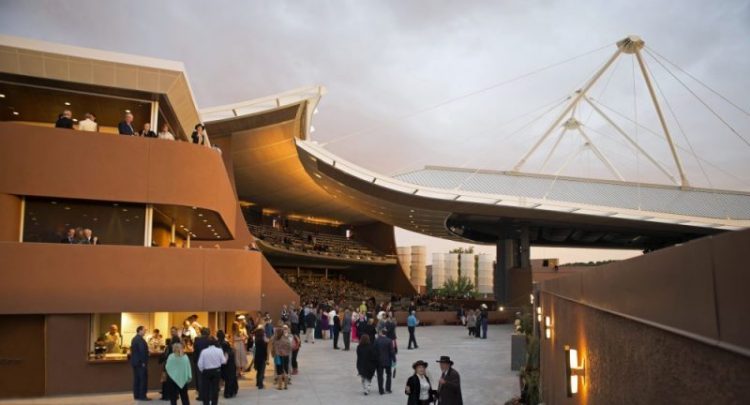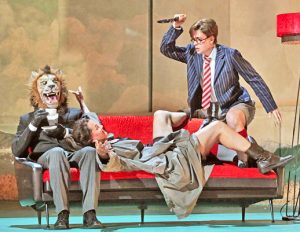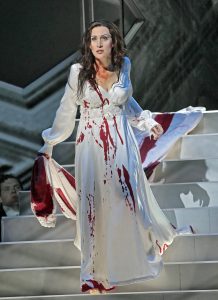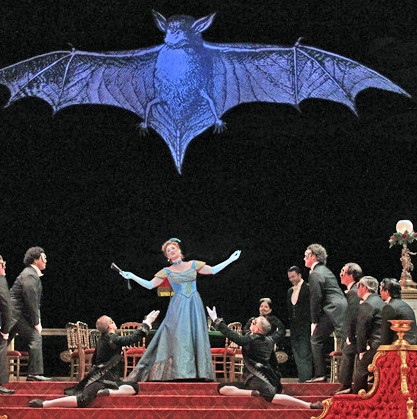
2017 in Santa Fe will be remembered for the sensational debut of The (R)evolution of Steve Jobs. In my decades of opera-going I’ve never seen such a crowd-pleasing world premiere. My review is in a separate story and, here, we’ll consider the other operas of this summer season.
Handel’s Alcina, written in 1735, made a strong though controversial impression. Some critics felt it’s new staging was outrageous, but I think it was clever. When we think of Handel we picture powdered wigs and formal, slow moving dramas. This production was nothing like that.
This was an immersive experience with principal singers making entrances through the audience. Dancers and acrobats expressed the feelings of the principals, and even the leading singers twirled and spinned as they trilled. The movements were motivated by the words in the original text. For example, if a soprano sang an aria about a lost love from her past, that former lover appeared and mimed an episode from their romance as she continued to sing.
The problem for modern audiences is that Handel adhered to a formula in which melodies were intentionally repeated, followed by a contrasting middle section, then another repetition of the first melody. Some listeners today find this to be tedious. Director David Alden handled this by having the performer sing the first section, then make a quick exit (say, through a door), then appear a few seconds later through another door to sing the repetition. Each section of each aria had new action — and sometimes a new costume. One could never get bored during these quick-change moments.
Alcina’s plot is about men loving women who, instead, love different men, and so on; complicated by the fact that one of the women is a sorceress who turns people with whom she is angry into jungle beasts. Below, Heever & Stucker in Alcina:
Elza van den Heever, the South African soprano who has sung leading roles at the Met and other major houses, was a tower of strength as the sorceress. Daniela Mack and Anna Christy were delightful as young women, Paula Murrihy and Jacquelyn Stucker were convincing as young men, tenor Alek Shrader was thrilling as Alcina’s General, and bass Christian Van Horn was sonorous as a tutor.
Harry Bicket, the London-born Handel specialist, led a musically gorgeous performance. Without any gimmicks, he provided an impressive amount of tonal variety and nuance from the orchestra pit.
The spectacular scenic and costume design were by Gideon Davey, the lighting design by Malcolm Rippeth, and the choreography by Beate Vollack. This production illustrated the innovation and high quality that the Santa Fe Opera has been providing for sixty years.
*
Lucia di Lammermoor, the second opera I attended during my four night visit to Santa Fe, had several notable aspects. Soprano Brenda Rae burst into prominence this January as the soprano ingenue opposite Stephanie Blythe in Rossini’s rare Tancredi in Philadelphia. She has a lovely lyric voice with accurate coloratura plus unusually strong projection. Her Lucia dominated the stage throughout the opera. With a combination of good looks, a lovely sound, and dazzling technique, Rae jumps to the top among all of todays’s Lucias.
In the mad scene, after she stabs to death her bridegroom on their wedding night, Lucia’s hallucinations were accompanied by a glass harmonica as written by Donizetti, rather than by the commonly-used flute. The instrument is a series of glass goblets containing differing amounts of water, thus giving them different pitches, and they’re played by the performer vibrating his or her fingers around the rims of the glasses. The instrument was invented by Benjamin Franklin.
I much prefer the glass harmonica over the flute for this scene. It projects a softer sound, an eerie tone, which matches Lucia’s state of mind. Bravo to Maestro Corrado Rovaris for choosing it, and to Friedrich Heinrich Kern for playing it, virtually unseen, in the pit. (This instrumentation can be heard on a recording with Beverly Sills, conducted by Julius Rudel, and in a French-language recording by Natalie Dessay.)
 During most of the rest of the opera, Rovaris chose tempi that often hit a fast gallop. The hammy acting, as directed by Ron Daniels, was disappointing except for Rae’s work. Tenor Mario Chang as Lucia’s true love Edgardo was leather-lunged; baritone Zachary Nelson as Lucia’s brother Enrico had ringing top notes and weak low ones. Tenor Carlos Santelli as the unfortunate groom Arturo and Christian Van Horn as the chaplain Raimondo each had some fine moments.
During most of the rest of the opera, Rovaris chose tempi that often hit a fast gallop. The hammy acting, as directed by Ron Daniels, was disappointing except for Rae’s work. Tenor Mario Chang as Lucia’s true love Edgardo was leather-lunged; baritone Zachary Nelson as Lucia’s brother Enrico had ringing top notes and weak low ones. Tenor Carlos Santelli as the unfortunate groom Arturo and Christian Van Horn as the chaplain Raimondo each had some fine moments.
The chorus, under the direction of Susanne Sheston, sang well, but it was a letdown to see them face the audience during the mad scene instead of interacting as if commiserating with each other. The scenic design by Riccardo Hernandez was unremarkable, lacking the originality of concept that Santa Fe Opera is known for.
Watch this video from Lucia.
*
The Santa Fe production of Johann Strauss’s Fledermaus was the least Viennese of any I’ve ever seen. Director Ned Canty kept the Old World setting and used New World language and action, and the coarse humor left few remnants of the elegant life in the 1870s Austrian monarchy.
Gemütlichkeit was missing here — that feeling of belonging together, with warmth, friendliness and good cheer which exemplified the Habsburg Empire in its finest hours. You could argue that the real Habsburg nobility were too self-satisfied but, even if unrealistic, their staged image can and should give a warm glow.
The orchestra under the baton of Nicholas Carter, principal conductor of the Adelaide Symphony Orchestra, gave a light, lyrical account. But some of the singers pushed and sounded edgy, and their mugging was excessive. Best in the cast were the Canadian baritone Joshua Hopkins as an elegant Dr. Falke who seeks revenge for being embarrassed by his friend Gabriel von Eisenstein, Jane Archibald as the maid Adele with dazzling coloratura and pert humor, and Susan Graham who was imperious as the unflappable and androgynous Prince Orlovsky.
Kurt Streit seemed awkward and inelegant as Eisenstein. Devon Guthrie as Eisenstein’s wife Rosalinda has a nice lyric voice but was inadequate as an imperious woman who dares to confront her philandering husband in public. She lacked the power to make her Hungarian czárdás a show-stopper.
Dimitri Pittas was blustery as Alfred, the former lover of Rosalinda who returns to spend a night with her when her husband is sent to jail. He’s supposed to be a self-centered Italian tenor, whose mannerisms should come easily to any tenor but Pittas seemed to have a tough battle. He pushed to the point where his voice lost its normal beauty. I must admit that I have high standards for this role; my first Alfred was the golden-voiced Richard Tucker.
David Govertsen as the prison warden and Kevin Burdette as the jailer Frosch were over-directed and their humor was heavy-handed. The Act II ballet was shortened by choreographer Sean Curran and was understaffed; only four dancers comprised the corps.
On the plus side, Allen Moyer’s set was clever — doorways and their frames represented a nobleman’s home, and walls were eliminated so the audience could see a beautiful New Mexican sunset through the open rear of the stage. Zach Brown’s costumes and Duane Schuler’s lighting were fine.
The production used the corny English translation from the 1950s by Ruth and Thomas Martin with updates by Charles Ludlam. To give you an idea of how this production tried to meld 1870s Austria with 2017 America, a character uses a dial phone to call his supervisor, fails to hear anything, holds up the phone and says “I can’t get through. I have only one bar.” (This was the night after we saw an opera about the inventor of the iPhone.) When Eisenstein’s inept lawyer is about to confer with him, someone says “there’s a notorious Justice nearby” — clearly a reference to the fact that Supreme Court Justice Ruth Bader Ginsburg was in the audience. She’s a regular attendee at the Santa Fe Opera.
This brings us to a discussion of what’s special about Santa Fe. It is America’s oldest state capital city and the smallest, with a population of only 83,000. At an altitude of 6852 feet, it’s one of America’s highest cities. The slogan is “the City Different.” I’d go farther and call it unique. First of all, the mountain views are gorgeous. Almost all structures are low and are made of tannish-pinkish adobe. The ambience is that of a small town; strangers on the sidewalks say “hello” to you. The pace is slow and relaxed. Yet it’s a hotbed of creative artistry, in paintings, sculpture, jewelry, cuisine and music.
For more about the city, click here.. And for my review of the Steve Jobs opera, click here!